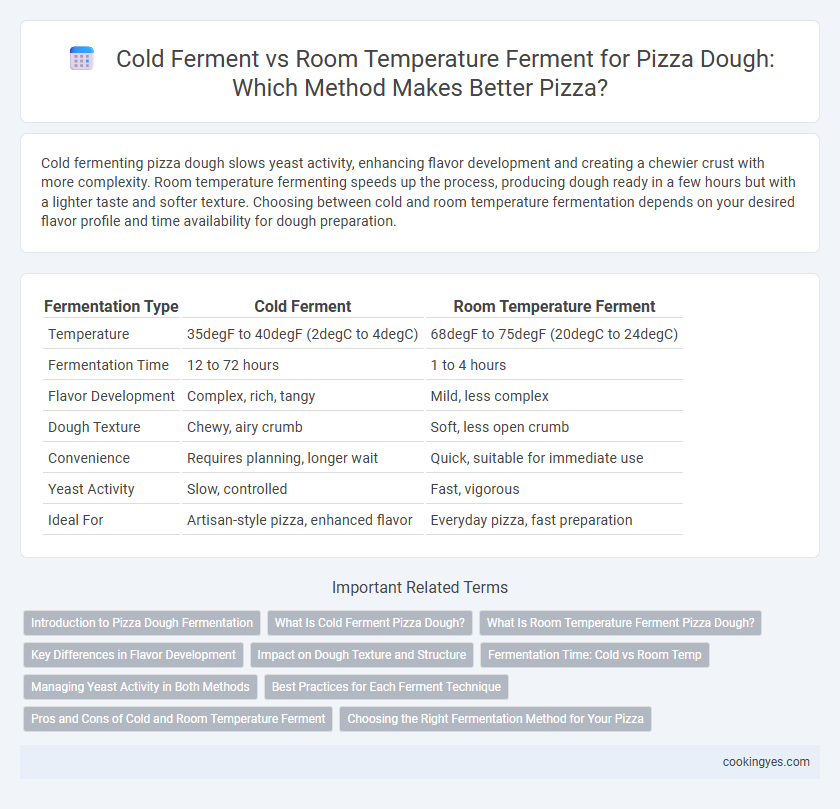Cold fermenting pizza dough slows yeast activity, enhancing flavor development and creating a chewier crust with more complexity. Room temperature fermenting speeds up the process, producing dough ready in a few hours but with a lighter taste and softer texture. Choosing between cold and room temperature fermentation depends on your desired flavor profile and time availability for dough preparation.
Table of Comparison
| Fermentation Type | Cold Ferment | Room Temperature Ferment |
|---|---|---|
| Temperature | 35degF to 40degF (2degC to 4degC) | 68degF to 75degF (20degC to 24degC) |
| Fermentation Time | 12 to 72 hours | 1 to 4 hours |
| Flavor Development | Complex, rich, tangy | Mild, less complex |
| Dough Texture | Chewy, airy crumb | Soft, less open crumb |
| Convenience | Requires planning, longer wait | Quick, suitable for immediate use |
| Yeast Activity | Slow, controlled | Fast, vigorous |
| Ideal For | Artisan-style pizza, enhanced flavor | Everyday pizza, fast preparation |
Introduction to Pizza Dough Fermentation
Cold fermentation of pizza dough typically occurs in a refrigerator at temperatures between 35degF and 45degF, slowing yeast activity and enhancing flavor development over 24 to 72 hours. Room temperature fermentation happens at approximately 70degF to 75degF, accelerating yeast fermentation and producing a softer dough within 1 to 4 hours. The choice between cold and room temperature fermentation significantly impacts dough texture, flavor complexity, and fermentation time in pizza preparation.
What Is Cold Ferment Pizza Dough?
Cold ferment pizza dough is a preparation method where dough is allowed to rise slowly in the refrigerator at temperatures between 34degF and 40degF for 24 to 72 hours. This process enhances flavor development by promoting the growth of beneficial yeast and bacteria, resulting in a dough with improved texture and a more complex, tangy taste. Compared to room temperature fermenting, cold fermentation controls yeast activity more precisely, reducing over-proofing and allowing for better gluten structure.
What Is Room Temperature Ferment Pizza Dough?
Room temperature ferment pizza dough undergoes the fermentation process at approximately 70-75degF (21-24degC), allowing yeast to activate quickly and develop flavor within a shorter timeframe of 4 to 8 hours. This method produces a dough with a slightly tangy taste and a softer texture due to faster gluten development and gas production. It contrasts with cold fermenting, which slows yeast activity for enhanced flavor complexity but requires extended fermentation in refrigeration.
Key Differences in Flavor Development
Cold ferment enhances pizza dough flavor by allowing slow yeast fermentation over 24 to 72 hours, producing more complex organic acids and improved gluten structure for a chewier texture. Room temperature ferment accelerates fermentation within 1 to 4 hours, resulting in a milder flavor profile with less pronounced sourness and a lighter, airier crust. The key difference lies in flavor depth, as cold fermentation develops richer, tangier notes, while room temperature fermentation yields a fresher, more subtle taste.
Impact on Dough Texture and Structure
Cold fermenting pizza dough for 24 to 72 hours enhances gluten development and promotes a more complex flavor profile, resulting in a chewier texture and a crispier crust. Room temperature fermentation accelerates yeast activity, producing a lighter, airier dough with larger, irregular holes but less depth of flavor. The cooler, slower fermentation strengthens dough structure by allowing gradual enzymatic activity, improving elasticity and oven spring.
Fermentation Time: Cold vs Room Temp
Cold fermentation of pizza dough typically takes between 24 to 72 hours, allowing slow yeast activity that develops complex flavors and a chewier texture. Room temperature fermentation usually lasts 2 to 6 hours, resulting in faster yeast activation and a softer crust with less depth of flavor. Extended cold fermentation enhances dough extensibility and gluten structure, while shorter room temperature fermentation accelerates proofing but may sacrifice taste complexity.
Managing Yeast Activity in Both Methods
Cold ferment slows yeast activity by maintaining dough at 4degC to 7degC, allowing controlled carbon dioxide release that enhances flavor and texture over 24 to 72 hours. Room temperature ferment accelerates yeast metabolism at 20degC to 25degC, resulting in faster dough rise within 2 to 6 hours but with less complex flavor development. Managing yeast activity requires adjusting yeast quantity and fermentation time to balance dough elasticity and taste in both methods.
Best Practices for Each Ferment Technique
Cold ferment enhances flavor complexity and dough strength by allowing gradual yeast fermentation at temperatures between 35-45degF over 24-72 hours, resulting in a crispier crust and improved digestibility. Room temperature ferment accelerates yeast activity at 70-75degF, typically completed within 1-3 hours, producing a lighter dough with immediate elasticity ideal for quick pizza preparation. Best practices include tightly covering dough during cold ferment to prevent drying and frequent monitoring of room temperature dough to avoid over-proofing and maintain optimal texture.
Pros and Cons of Cold and Room Temperature Ferment
Cold ferment enhances dough flavor and texture by slowing yeast activity, allowing complex gluten development and yielding a chewier crust, but it requires extended time and refrigeration space. Room temperature ferment accelerates yeast fermentation, producing quicker results and a softer texture ideal for fast preparation, yet it may result in less depth of flavor and can risk overproofing if not closely monitored. Choosing between cold and room temperature ferment depends on desired crust characteristics and available time constraints for dough preparation.
Choosing the Right Fermentation Method for Your Pizza
Cold fermentation enhances dough flavor and texture by allowing slow yeast activity in the refrigerator over 24-72 hours, producing complex, tangy notes and a chewier crust. Room temperature fermentation accelerates yeast activity within 2-6 hours, resulting in a softer, less tangy dough ideal for quick preparation. Selecting between cold and room temperature fermentation depends on your desired flavor profile and available preparation time for pizza dough.
Cold ferment vs room temperature ferment for pizza dough Infographic

 cookingyes.com
cookingyes.com